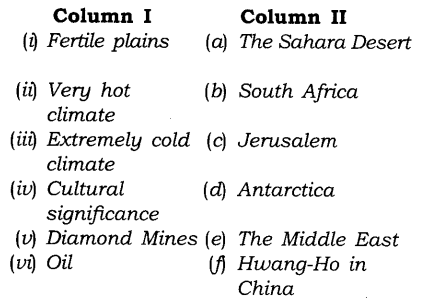EVENTS CONVENT HIGH SCHOOL
28/01/2022 CLASS- 8 SESSION 2021-22
SUBJECT : SOCIAL SCIENCE(Geography)
CHAPTER-6
HUMAN RESOURCES
______________________________________
Question 1.Choose the correct option.
(i) The most populated continent is
(a) Asia
(b) Africa
(c) Europe
(d) South America
(ii) The least number of people live in this continent
(a) North America
(b) Europe
(c) Oceania
(d) Antarctica
(iii) According to population, what is India’s rank in the world?
(a) 7th
(b) 2nd
(c) 5th
(d) 1st
(iv) Which of these countries has a population below 100 million?
(a) Japan
(b) Peru
(c) USA
(d) India
(v) What is the average population density of the world? (in persons per sq km)
(a) 300
(b) 100
(c) 45
(d) 10
(vi) In which country is the city of Osaka located?
(a) UK
(b) South Korea
(c) Japan
(d) None of these
(vii) Which of these countries is notable for the number of people who emigrate outside from there?
(a) Sudan
(b) Australia
(c) New Zealand
(d) None of these
(viii) Which of these characteristics of a population pyramid indicates the lowest levels of literacy and development?
(a) broad base, narrow top
(b) broad base, steady slope
(c) narrow base, narrow top
(d) broad base, broad top
Answer:
(i) (a), (ii) (d), (iii) (b), (iv) (b), (v) (c), (vi) (c), (vii) (a), (viii) (a).
Question 2.
Fill in the blank spaces given to complete each sentence.
- ……….. is considered to be the ultimate resource.
- More than 90% of the world’s population resides on just …………… per cent of the total land surface.
- The top ten countries in population cover about …………. per cent of the total world population.
- ……….. is the most populated country in North America.
- The world’s population reached a billion in the year ………….
- Birth rate and death rate are usually expressed in terms of per ………… people.
- The difference between the ……… and the ………… is called natural growth rate of population.
- The age group 0-15 comes under the economically ………….. group.
Answer:
- Human resource
- ten
- sixty
- USA
- 1820
- 1000
- birth rate, death rate
- dependent
Question 3.
State whether each of the following statements is true (T) or false (F).
- Many more people live to the south of the Equator than the north.
- Each of the top ten populated countries has a population of over 100 million.
- South-Central Asia has the highest density of population.
- The population of the world doubled between 1820 and 1999.
- In the United Kingdom, the birth rate as well as the death rate is low.
- Japan and Bangladesh are very densely populated. We can conclude that both are economically underdeveloped.
Answer.
- False
- True
- True
- False
- True
- False
Question 4.
Match the items given in Column I correctly with those given in Column II.
Answer:
(i) (f), (ii) (a), (iii) (d), (iv) (c), (v) (b), (vi) (e).
Very Short Answer Type Questions
Question 1.
In what respects do different human beings differ?
Answer:
Human beings differ from each other in age, sex, education, ethnicity, culture, physical and mental strength, etc.
Question 2.
With the help of figures, describe how the population varies across continents.
Answer:
Around 61% of the world’s population lives in Asia, 12% in Europe, 13% in Africa, 8% in Central/South America, 5% in North America, and 1% in Oceania.
Question 3.
If 600 people live in your colony, and the area of your colony is 2 sq km, what is the population density of your colony?
Answer:
If 600 people live in a 2 sq km area, on average, 300 people live in 1 sq km. So the density of the population is 300 persons per sq km.
Question 4.
Compare the population density of the world with that of India.
Answer:
The population density of the world is around 45 persons per sq km, whereas that of India is over 320 persons per sq km.
Question 5.
How does climate affect the population distribution of an area?
Answer:
People prefer to live in regions with a moderate climate, and not places of the extreme cold and hot climate. So moderate climate regions are densely populated.
Short Answer Type Questions
Question 1.Answer the following questions.
(i) Why are people considered a resource?
(ii) What are the causes for the uneven distribution of population in the world?
(iii) The world population has grown very rapidly. Why?
Answer.
(i) Human beings are the most important resource of a nation. They are significant because had they not utilised their brains, the other resources of nature would not have found any utility. In other words, human resource is the ultimate resource.
(ii) Population density depends on the climate conditions and topography of the place, like few people live in high latitude areas, tropical deserts, mountainous ‘terrains, and forest areas,whereas a large number of people reside in plains. Fertility of soils, availability of fresh water, minerals are other major geographical factors behind this. Some social factors that boost the density of population in a region are better housing, education and health facilities. Places with cultural or historical significance are usually populated. Employment opportunities are another attraction for large chunks of population.
(iii) Because of the better food supplies, increase in medical facilities, reduced death rate, birth rate almost remaining the same.
- The difference between birth rate and death rate is called natural growth rate. This natural growth is high due to better medical and food facilities leading to growth in population.
- Many people move from one country to another due to various reasons. This also leads to increase in population of the countries having his immigration.

